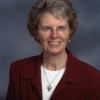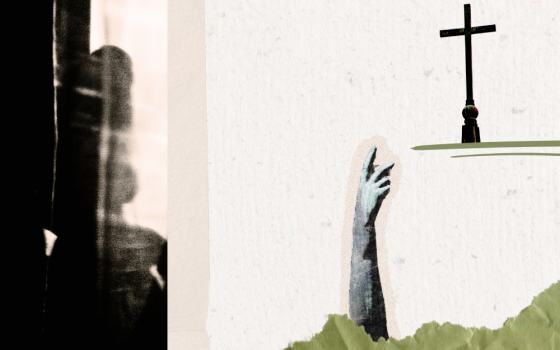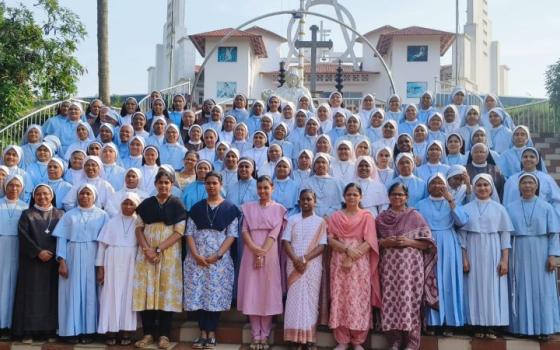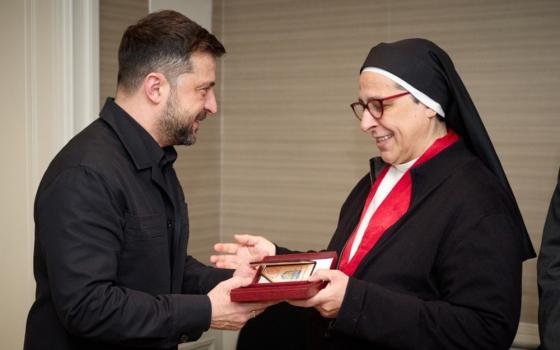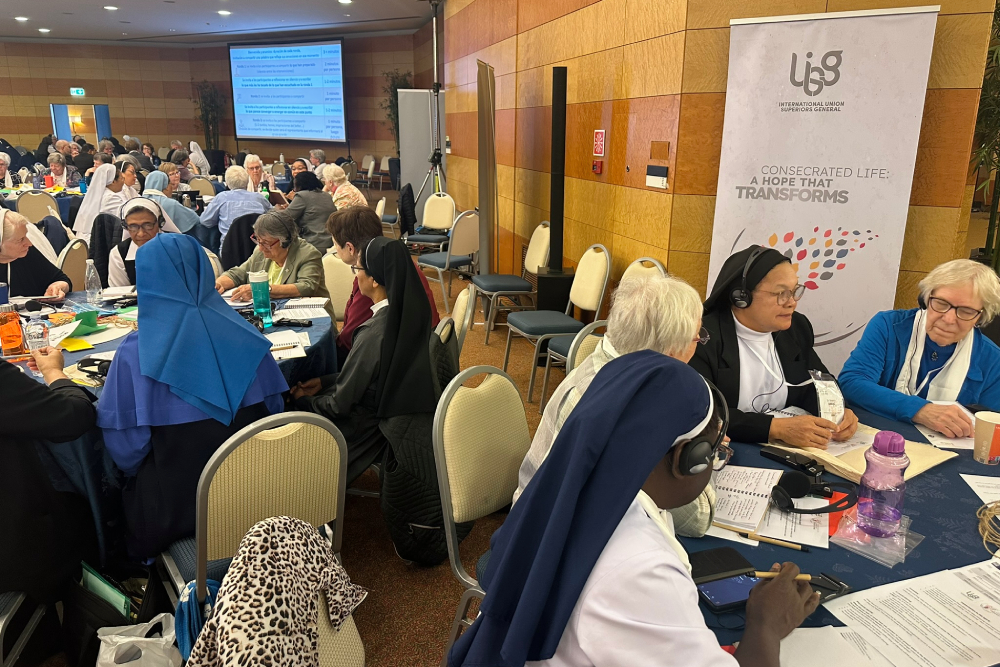
On the opening day of the May 5-9 general assembly for the International Union of Superiors General in Rome, sisters engaged in table discussions that modeled the format experienced at recent synods. "At first, for some the method was new," Sr. Joyce Meyer writes. "But we quickly became comfortable as we evolved into a community. It was an amazing experience to see how even in this short time, shared experience deepened." (GSR photo/Soli Salgado)
When we first signed up for the International Union of General Superiors assembly several months ago, nobody expected that we would be there at the same time as the conclave to elect a new pope. However, following Pope Francis' sudden death, most of us came to the May 5-9 gathering in Rome with anticipation (some, with anxiety) about who the new pope would be.
These feelings were set aside as the assembly of nearly 1,000 leaders congregated with a lot of joy in being together, and we began our work to strengthen our vocation to be witnesses of hope.
And between the open table discussions and an inspiring keynote speaker — and the week being topped off with the election of a new pope — there was no shortage of hope for an emerging synodal church.
UISG president Sr. Mary Barron, a Missionary Sister of Our Lady of the Apostles, introduced the assembly theme — Consecrated Life: A Hope That Transforms — and reminded us that Pope Francis depended on consecrated life to support his vision and keep alive the flame of renewal for the church.
My experience of the four days was deeply moving as we practiced deep communal prayer and learned the synodal way of contemplative dialogue with one another: the planners wanted to give us a taste of what the synod participants had experienced in their time together. I was happy to have the opportunity to be part of a members' table, even though I was representing Global Sisters Report.
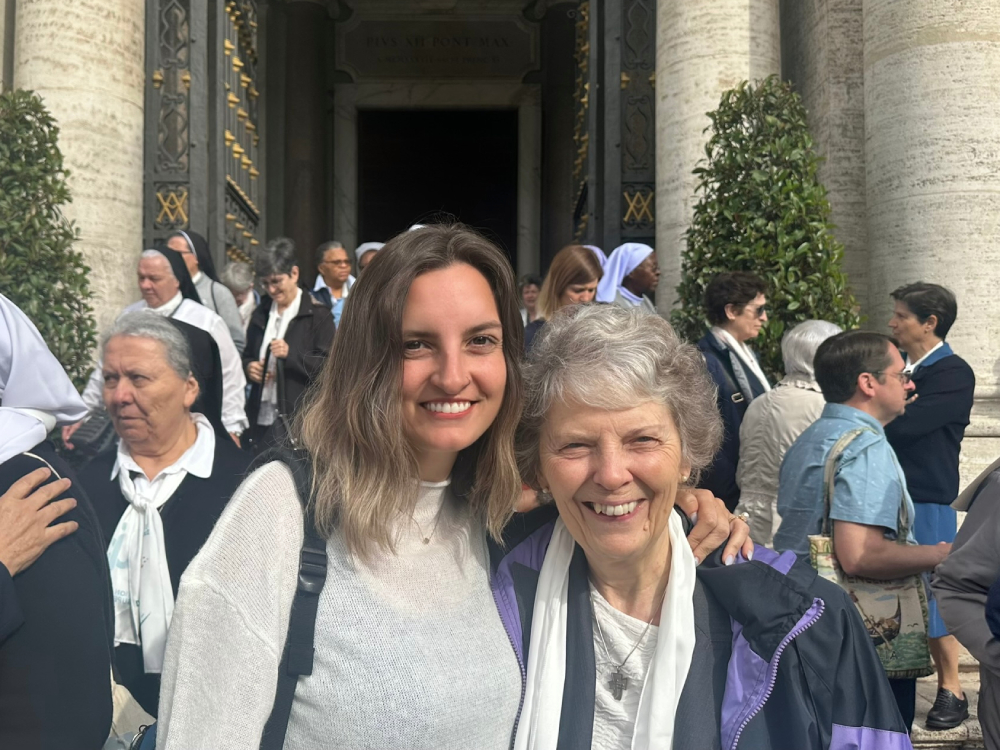
GSR editor Soli Salgado and GSR's international liaison to women religious, Sr. Joyce Meyer, at the Basilica of St. Mary Major, May 9. The assembly concluded the week with a visit to Francis' tomb and Mass. (Photo provided by Soli Salgado)
One of our group facilitators began by reminding us of the method that included several rounds of listening, sharing and reflecting to the group what we heard and eventually how it would lead to conclusions to share with the assembly. At first, for some the method was new — and of course, we were all strangers to each other — but we quickly became comfortable as we evolved into a community. It was an amazing experience to see how even in this short time, shared experience deepened.
Joyous breaking news
Having so many women religious gathered in groups of silence and contemplative prayer was powerful: I personally believe that our presence together during the conclave was not a coincidence, but a movement of the Spirit. Women's prayerful presence was needed — another confirmation of what synodal inclusion in the Church is about.
I will never forget the moment when the shout went up as we were ending communion reception at Mass, May 8. Immediately the screen in the front of the room showed the white smoke sifting its way out of the chimney. The sisters began shouting, jumping up and down and then singing in joy. It was electric. Some began rushing to get out of the room to get down to St. Peter's Square; the rest of us stayed to finish Mass, missing the new pope's appearance on the balcony. Some of us went down to the square anyway, and the atmosphere of the thousands of people gathered was exhilarating and, at the same time, filled with disbelief and amazement that a U.S. native was elected pope. I had never dreamed it would happen in my lifetime.
Signs of hope for women
Prior to all of this excitement, along with experiencing the method of prayer and contemplative dialogue, we listened to voices of inspiration throughout the assembly.
Sacred Heart Sr. Mariola López Villanueva was our first keynote speaker who inspired us with what had been ignited in her as a synod participant. She named three signs of hope: experiencing the synod as a hopeful event for all women; initiatives taken by two important Pan-African organizations to strengthen leadership of women religious; and a commitment for religious to continue witnessing that religious life is itself a place of hope in Jesus Christ.
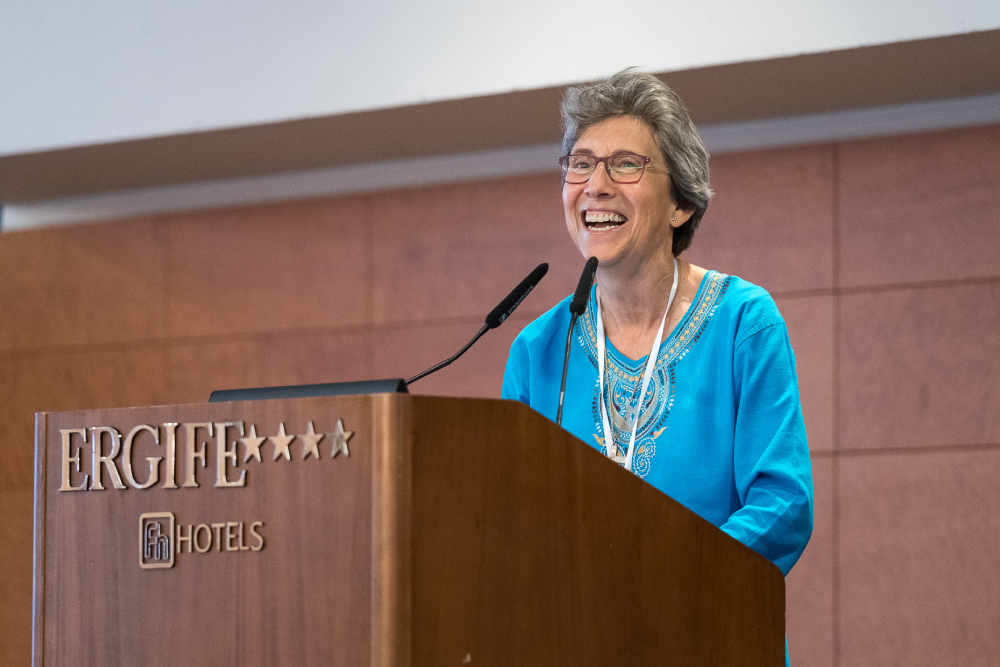
A synod participant, Sacred Heart Sr. Mariola López Villanueva was the first keynote speaker at the UISG generally assembly, inspiring the crowd by sharing several signs of hope from her experience at the synod. (Photo provided by UISG)
She noted that the women who participated in the synod found that male participants, clergy and laypeople warmly engaged them and acknowledged that, by virtue of baptism, women have equal dignity as members of the people of God and are co-responsible for mission according to vocation, competence and experience. This was supported by shared conversations about holy women's encounters with Christ: Sts. Lutgarde and Mechtilde of Hackeborn, Angela of Foligno and Julian of Norwich, all bearing witness to Christ's choice of them to roles not often acknowledged by their contemporaries.
As I listened to Solange, I found myself wondering how the men were hearing these stories, particularly since at the end of the synod, roles for women in church ministry remained in the study section.
López also recalled feeling hope in hearing from women in Africa who play central roles in their community and ecclesial life, a promising sign that it will continue and grow into the future. But she also acknowledged that there are still many challenges for women and thus, formation and integration of women into the fullness of church life is very necessary.
Her second hope came later in the launching of a leadership training project for women religious in African countries through collaboration of two important Pan-African organizations: the Pan-Africa Network of Catholic Theology and Pastoral Care, in collaboration with the Confederation of Major Superiors of Africa and Madagascar (COMSAM). The synodal process revealed that there were areas of the world where women religious are not in leadership roles because they lack necessary skills. With training, this could — and hopefully will — change.
Advertisement
Through training, López's hope is that good leadership practice in religious communities would be promoted to make religious life a place of transformation and hope for all its members. Transformational leadership is needed where elected or non-elected leaders walk together, side by side, not hierarchically; that is too often the practice. It is community-based, grassroots leadership that requires that all members are trained in communication, empathy and strategic vision. They also should be able to engage in such a way that everyone elevates one another to higher levels of motivation and morality to accomplish common goals or development, both within their congregations and in their church communities.
The synodal process revealed that there were areas of the world where women religious are not in leadership roles because they lack necessary skills. With training, this could — and hopefully will — change.
Transformational leaders, she said, are those that seek to empower and encourage their members, always concerned with maximizing their potential. They also attempt to raise the consciousness of their members by leading them by example to transcend personal interests for the benefit of others. They are servant leaders who use less institutional power and less control, sharing their authority with others, as Jesus did. This kind of authority leaves members feeling respected, accepted and trustworthy, encouraged to use their personal charisms for the good of those they serve. "The Son of Man came not to be served, but to serve, and to give his life as a ransom for many" (Mark 10:45).
López's third hope from the synod is that religious life itself will always be a bearer of hope for the world. She noted that Jean Baptiste Metz held that religious have dual roles as innovators and correctors. Religious are often those who first perceive changes in history and rise to meet these challenges. At other times they provide "shock therapy" through the work of the Holy Spirit. These dynamics are essentials in religious life and a source of healing of society.
This new global movement of synodality is a challenge for all of us to take advantage of opportunities to become servant leaders raising our voices and carrying these charisms of religious life into our world today. We also need to raise others up to use their voices as all the baptized have equal dignity as members of the people of God and share in Christ's mission in the world. As was the pattern of the days at the general assembly, we were called to silence and then sharing, culminating in a plenary of single voices, either asking questions or affirming the input. The first day together was exhilarating.
